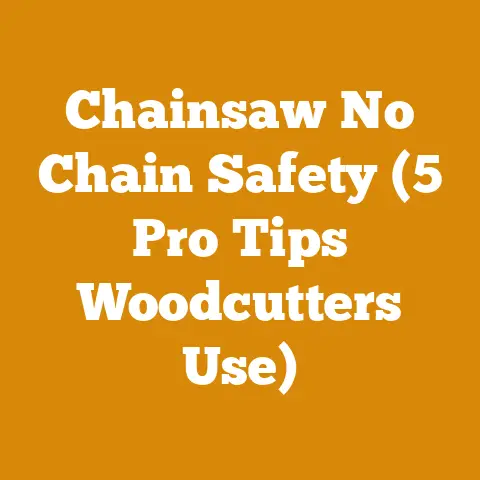2nd Hand Chainsaws for Wood Processing (Buying Tips & Expert Insights)
As someone deeply entrenched in the world of wood processing, I’ve always believed in making eco-conscious choices. That’s why I’m a big proponent of giving second-hand chainsaws a new lease on life. Not only does it save you money, but it also reduces waste and promotes sustainability. In this article, I’ll share my expert insights and buying tips to help you find the perfect used chainsaw for your wood processing needs.
Key Takeaways:
- Evaluate your needs: Determine the size and type of wood you’ll be processing to choose the right chainsaw.
- Inspect the chainsaw thoroughly: Check for signs of wear, damage, and proper maintenance.
- Test the chainsaw: Start it up, listen to the engine, and observe its performance.
- Negotiate the price: Research the market value of similar used chainsaws and be prepared to haggle.
- Consider reputable sources: Buy from trusted dealers or individuals with a good reputation.
Finding the Right Second-Hand Chainsaw: A Wood Processor’s Guide
Why Choose a Second-Hand Chainsaw?
Let’s face it, a brand-new chainsaw can be a significant investment. But a well-maintained second-hand chainsaw can offer excellent performance at a fraction of the cost. It’s a win-win for your wallet and the environment.
Cost Savings: Used chainsaws typically sell for 30-70% of their original price, depending on their condition and age.
Environmental Benefits: Buying used reduces the demand for new products, conserving resources and reducing waste.
Opportunity to Find High-Quality Models: You might find a high-end model that’s no longer in production but still performs exceptionally well.
Assessing Your Needs: What Type of Wood Will You Be Processing?
Before diving into the market, it’s crucial to assess your specific needs. Are you planning to process small branches for kindling, large logs for firewood, or something in between? The size and type of wood you’ll be processing will determine the appropriate chainsaw size and power.
Small Branches and Limbs (up to 6 inches): A lightweight chainsaw with a 14-16 inch bar is ideal.
Medium-Sized Logs (6-12 inches): A mid-range chainsaw with a 16-18 inch bar will provide sufficient power.
Large Logs (12 inches and up): A heavy-duty chainsaw with an 18-20 inch or longer bar is necessary.
Type of Wood: Hardwoods like oak and maple require more power than softwoods like pine and fir.
Gas vs. Electric Chainsaws: Which is Right for You?
Both gas and electric chainsaws have their pros and cons. Gas chainsaws offer more power and portability, while electric chainsaws are quieter, lighter, and require less maintenance.
Gas Chainsaws:
- Pros: High power, long run time, suitable for heavy-duty tasks.
- Cons: Noisier, require more maintenance, exhaust fumes.
Electric Chainsaws:
- Pros: Quieter, lighter, less maintenance, no exhaust fumes.
- Cons: Limited power, shorter run time (battery-powered), require a power outlet (corded).
Where to Find Second-Hand Chainsaws
Online Marketplaces: Websites like Craigslist, eBay, and Facebook Marketplace offer a wide selection of used chainsaws. Be sure to exercise caution and thoroughly inspect the chainsaw before purchasing.
Local Dealers: Some chainsaw dealers also sell used models. This option often provides more security and potential for warranty.
Pawn Shops: Pawn shops can be a good source for finding used chainsaws at discounted prices.
Friends and Family: Ask around your network – someone might be looking to sell their old chainsaw.
Visual Inspection
Overall Condition: Look for signs of excessive wear, damage, or neglect.
Bar and Chain: Check the bar for straightness, wear, and damage. Examine the chain for sharpness, rust, and missing teeth.
Housing: Inspect the housing for cracks, breaks, or missing parts.
Fuel and Oil Tanks: Check for leaks, cracks, and proper sealing.
Air Filter: Ensure the air filter is clean and in good condition.
Spark Plug: Inspect the spark plug for wear, fouling, and proper gap.
Mechanical Inspection
Compression Test: A compression test can reveal the condition of the engine’s cylinders, piston rings and valves. A low compression reading indicates a worn engine. I highly recommend you to get a compression tester and measure the compression by yourself.
Starting Mechanism: Check the recoil starter for smooth operation and proper engagement.
Throttle and Choke: Ensure the throttle and choke levers move freely and return to their original positions.
Chain Brake: Test the chain brake to ensure it engages quickly and effectively.
Testing the Chainsaw
Starting the Engine: A healthy chainsaw should start easily after a few pulls.
Idling: The engine should idle smoothly without stalling or excessive vibration.
Acceleration: The engine should accelerate smoothly and quickly when the throttle is engaged.
Chain Speed: Observe the chain speed while cutting. It should be consistent and efficient.
Smoke: Excessive smoke can indicate a problem with the engine or fuel mixture.
Common Problems to Watch Out For
Worn Cylinder: Low compression, difficult starting, and loss of power are signs of a worn cylinder.
Damaged Piston: Scratches, cracks, or holes in the piston can cause engine failure.
Faulty Carburetor: A dirty or damaged carburetor can cause starting problems, poor idling, and stalling.
Leaking Seals: Leaking seals can cause loss of compression and fuel leaks.
Broken Chain Brake: A broken chain brake is a safety hazard and should be repaired immediately.
Negotiating the Price and Making the Purchase
Researching Market Value
Before making an offer, research the market value of similar used chainsaws. Check online marketplaces, local dealers, and pawn shops to get an idea of the going rate.
Negotiating Tactics
Point Out Flaws: Use any flaws or issues you discovered during the inspection as leverage to negotiate a lower price.
Be Prepared to Walk Away: Don’t be afraid to walk away if the seller is unwilling to negotiate.
Offer a Fair Price: Start with a reasonable offer based on your research and the chainsaw’s condition.
Payment Methods
Cash: Cash is often the preferred method for private sales.
Credit Card: Some dealers may accept credit cards, but be aware of potential fees.
PayPal: PayPal offers some protection for buyers and sellers.
Final Checks Before Purchase
Bill of Sale: Obtain a bill of sale that includes the seller’s name, address, and contact information, as well as the chainsaw’s make, model, and serial number.
Warranty: If purchasing from a dealer, inquire about any warranty coverage.
Return Policy: Clarify the return policy before making the purchase.
Maintaining Your Second-Hand Chainsaw: Tips and Tricks
Regular Cleaning
Air Filter: Clean the air filter regularly to ensure proper airflow.
Chain and Bar: Clean the chain and bar after each use to remove debris and prevent rust.
Housing: Wipe down the housing to remove dirt and grime.
Sharpening the Chain
A sharp chain is essential for efficient and safe cutting. Learn how to sharpen your chain using a file or chain grinder.
Lubrication
Bar and Chain Oil: Use high-quality bar and chain oil to lubricate the chain and bar.
Engine Oil: Change the engine oil regularly according to the manufacturer’s recommendations.
Fuel Storage
Store fuel in a clean, airtight container in a cool, dry place. Use fuel stabilizer to prevent fuel degradation.
Seasonal Maintenance
Winterizing: Before storing your chainsaw for the winter, drain the fuel tank, clean the air filter, and lubricate the chain and bar.
Spring Tune-Up: Before using your chainsaw in the spring, check the spark plug, air filter, and fuel lines.
Safety First: Operating Your Chainsaw Safely
Personal Protective Equipment (PPE)
Helmet: Wear a helmet to protect your head from falling debris.
Eye Protection: Wear safety glasses or goggles to protect your eyes from flying chips.
Hearing Protection: Wear earplugs or earmuffs to protect your hearing from the chainsaw’s noise.
Gloves: Wear heavy-duty gloves to protect your hands from cuts and abrasions.
Chainsaw Chaps: Wear chainsaw chaps to protect your legs from accidental cuts.
Steel-Toed Boots: Wear steel-toed boots to protect your feet from falling logs and chainsaw injuries.
Safe Cutting Techniques
Proper Stance: Maintain a stable stance with your feet shoulder-width apart.
Grip: Grip the chainsaw firmly with both hands.
Cutting Direction: Cut away from your body and avoid cutting above shoulder height.
Kickback: Be aware of the risk of kickback and take precautions to avoid it.
Emergency Shut-Off: Know how to quickly shut off the chainsaw in case of an emergency.
First Aid Kit
Keep a well-stocked first aid kit on hand in case of injuries.
Case Studies: Real-World Examples of Successful Second-Hand Chainsaw Use
Case Study 1: Small Farm Firewood Production
A small farm in rural Vermont relies on firewood for heating. The owner purchased a used Stihl MS 271 chainsaw for \$350. After performing some basic maintenance and sharpening the chain, the chainsaw has been used to process over 10 cords of firewood per year for the past three years. The owner estimates that the used chainsaw has saved them over \$1,000 compared to buying a new model.
Case Study 2: Urban Tree Removal Service
An urban tree removal service in Seattle, Washington, purchased a used Husqvarna 455 Rancher chainsaw for \$250. The chainsaw is used for small tree removal jobs and pruning. The owner reports that the used chainsaw has been reliable and efficient, and has helped them save money on equipment costs.
Expert Insights and Quotes
Quote from a Professional Logger: “I’ve been using chainsaws for over 20 years, and I’ve found that a well-maintained used chainsaw can be just as good as a new one. The key is to inspect it thoroughly and perform regular maintenance.”
Insight from a Chainsaw Repair Technician: “The most common problems I see with used chainsaws are worn cylinders, damaged pistons, and faulty carburetors. A compression test is a great way to assess the condition of the engine.”
The Future of Second-Hand Chainsaws
The market for second-hand chainsaws is likely to continue to grow as more people become aware of the cost savings and environmental benefits. Advances in technology, such as battery-powered chainsaws, may also impact the market.
Data Point: The global chainsaw market is expected to reach \$4.5 billion by 2027, with a significant portion of sales coming from the used market.
Conclusion: Embrace the Power of Second-Hand
Buying a second-hand chainsaw can be a smart and sustainable choice for wood processing. By following the tips and guidelines outlined in this article, you can find a reliable and efficient chainsaw that meets your needs and budget. So, go ahead and explore the world of used chainsaws – you might be surprised at what you find!






